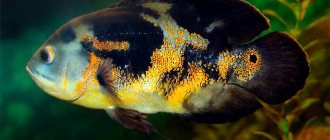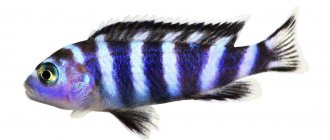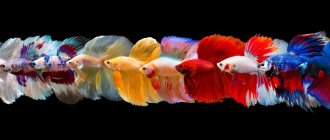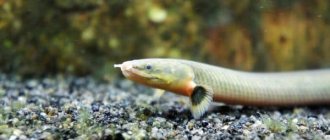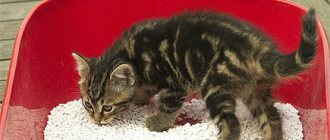Pineapple is a fish with an amazing structure and lifestyle. Translated from ancient Greek Ἀνάβασις means “ascent.” The name accurately reflects the way of life of the slider fish. She can not only crawl over land in search of a reservoir, but even climb trees. The unprepossessing appearance (the fish looks like a perch or chub) compensates for its unusual behavior for a fish. Pineapple is not a common inhabitant of aquariums, but exotic lovers are ready to maintain a species aquarium for the sake of this unique ancient fish.
Story
In 1792, the persimmon was described and systematized by the German naturalist and ichthyologist M.E. A flea called Anabas testudineus. The fish belongs to the creeping family, the genus Anabass, which includes 2 species (Anabas testudineus and Anabas cobojius). In Europe, the Anabass appeared in the exhibition of the London Zoological Park in 1870. The creeper fish arrived in the USSR only in 1960. In some countries, there are fish farms that breed Anabas not only for sale in aquariums, but also for tasty meat.
Habitat
Both fish species are native to South Asia. Anabas testudineus in Southeast Asia, including southern China, Indonesia, Malaysia, Burma, Laos, Vietnam, Philippines, Sri Lanka. And Anabas cobojius in India and Bangladesh. Pineapple prefers shallow, well-warmed fresh or brackish water bodies.
Fish are found in canals, ponds, swamps and estuaries, and flooded rice fields. Pineapples are not only found in stagnant bodies of water. Adults can live in slow-moving rivers and streams. They tolerate turbid water with low oxygen content well. They prefer shallow bodies of water with abundant vegetation.
During the dry season, the fish can bury itself in the mud to a depth of 1 m and remain in a damp “niche” for several weeks.
Description and natural habitat
Anabas has a large head, reddish eyes, and a large mouth. The body has well-developed cartilaginous external swimming organs with spines. The fish is protected by fairly large scales. There are transverse lines (8-10 pieces) on the sides of the body. The belly is yellowish, the back is dark, the fins are orange or red. The color of the Pineapple can be brown, gray-green or gray-brown. Quite rarely - orange.
Females are larger than males. The Crawler Fish has a special epibranchial organ (labyrinth), which serves for breathing (up to 6-8 hours) atmospheric air. Pineapple can live for two days in an unfavorable environment when drought occurs. Under normal conditions, the life span of fish is 5 years.
Photo gallery of Anabasov:
It is helped to climb trees and change habitat (crawl up to 500 m) by strong fins and gill covers covered with small scales. They have sharp spine-like processes. When moving, the crawler throws its body forward by pushing with its strong tail. During drought, a small fish can go deep into the mud, make a cocoon out of it to retain moisture, and wait for its habitat to improve.
Prefers to live in slightly brackish or fresh water with or without slow currents. The bottom should be muddy.
Suitable places for slider fish are:
- ditches;
- rice fields;
- small lakes;
- shallow ponds;
- drying up rivers.
There are two types of Anabass - giant (the body is elongated by 25-30 cm) and ordinary (the body length is 20-25 cm in nature and up to 16 cm in an artificial reservoir). The first species is often found in the hot territory of India, and the second - in Southeast Asia. The Creeper's habitat is China, Laos, Malaysia, the Philippines, Sri Lanka and a number of islands in Indonesia.
Shy Anabass become more active in the evening and at night. As predators, they can be aggressive, especially when the water temperature rises. Joint keeping is possible only with species of similar size.
Structural features and appearance
In nature, length of the common climbing persimmon reaches 20 cm, the Gangetic persimmon is somewhat larger - up to 30 cm. The body shape depends on the age of the fish and nutrition.
Pineapple has a dense, elongated body with an almost flat back. Slightly compressed from the sides. The head is large, wedge-shaped with a large mouth , which appears even larger due to the dark stripes framing the mouth opening and going down to the gill covers. The eyes are large and protruding with a reddish-orange stripe around the pupil. The fish can roll its eyes like a chameleon, which provides a good view.
The gill covers are solid and have large sharp serrations along the edges, which help the fish move through trees. The fish uses them like a climber with an ice ax, clinging to the slightest irregularities. Thanks to these spines, the persimmon is released from the nets, breaking the strong fibers.
The dorsal fin is long with sharp spines. The pectorals and anus are muscular with hard, spiny rays. The abdominal ones are located under the base of the pectoral ones. With their help, the fish crawls quite briskly across land. The caudal fin is rounded.
The body color is dull – gray-brown or olive. The back is darker in color. In young fish it may have an orange coloration. The abdomen is yellowish-white. The sides are covered with oblique stripes (up to 10 pieces), consisting of small dark spots. In young fish, the stripes are clearly visible; with age, the spots fade, and the fish acquires a uniform color.
Large single dark spots are visible on the gill covers and caudal peduncle. At the back of the head there is a large red-brown spot. The body is covered with large, jagged scales, and the base of the dorsal and anal fins is small.
Pineapple belongs to the labyrinthine genus. It is the labyrinthine organ that allows fish to travel on land, as it provides breathing with atmospheric air.
Pineapples exhibit sexual dimorphism. Males have a wider head. During the mating season, its color intensifies, the fins and the spot on the back of the head become red. The female is smaller and fuller, especially in the abdominal area. It has a more modest coloring.
Description
The creeper (Anabas testudineus) lives in the waters of Southeast Asia, and ponds for the Anabass can be temporary or permanent. The fish moves on land and crawls through trees, and is capable of covering up to 100 m in an hour. Can survive without water for up to 48 hours. Such survival is ensured by the labyrinthine respiratory organ, located above the gill arches and allowing the animal to breathe air. Pineapples are also eaten.
Appearance
Pineapple grows up to 25 cm in nature, and in an aquarium - up to 16 cm. The body is elongated. Large scales are beige, greenish or gray-brown. The back is darker in color, the belly is yellowish. There are stripes on the sides. The large head has large amber eyes. Powerful fins of a reddish hue. There are spines on the tail of the fish and in the area of the gills, which allow the slider to move over uneven surfaces.
Behavior
During the day, the creeper fish rests in shelters, and at night it goes out hunting. The predator is aggressive, but timid.
Lifespan
Pineapple lives in captivity for no more than 5 years.
Conditions in the aquarium
Pineapple is a fish that can adapt to life in a home aquarium, but this will require certain conditions:
- Selection of capacity . A couple of crawlers require an aquarium of more than 100 liters. It is optimal to keep perches in a group of 4-6 individuals. There should be an equal number of males and females in a flock, or females should predominate. The container must be tightly closed with a lid or glass so that the fish cannot leave the aquarium.
- Water parameters : temperature – +26-30°C; hardness – 20°dH; pH – 6.8-8.0.
- A good filter , since voracious persimmons leave a lot of waste products, and a water heater. Aeration is desirable, but not necessary. You need to change up to 20% of the water weekly (read more about how to properly change the water in an aquarium).
- Soil . The bottom of the aquarium is covered with fine river sand.
- Vegetation : bottom and floating plants. The most popular plants for an aquarium with Anabass are: hygrophila, cryptocoryne, limnophila, rotala, vallisneria, fern, etc. They will create dense thickets, but the plants need to be planted in such a way that there are “clearings” for swimming. Floating plants provide the necessary shading that crabapples love.
- Shelters - driftwood, grottoes, stone slides, ceramic shards. Decorative elements decorated with Java moss, monosolenium tenerum, and weeping moss will fit into the aquarium design.
Breeding and reproduction
Pineapple reaches sexual maturity at 1.5 years. For breeding to be successful, the male and female should be placed in a spawning tank.
During spawning, it will need to maintain a temperature within +25-30°C, acidity - no higher than 7.5, and hardness - no more than 10.
In addition, frequent water changes are necessary.
Egg spawning occurs in the middle water column or on the ground surface. The female lays about 4,500 eggs, which float to the surface and drift. After this, the parents must be returned to the community aquarium, since they do not care for the offspring. After a day, the fry hatch into the light. Already on 2-3 days they are able to swim and feed on their own. At first, rotifers and “live dust” are excellent food options.
Keeping crabapples is not difficult. Even a beginner can cope with the task, especially since the fish can tolerate even extreme conditions - high levels of ammonia and nitrates/nitrites in the water. Pineapple is one of the most exotic inhabitants of home aquariums with interesting behavior and lifestyle. Under appropriate conditions, they will delight with their presence for a long time.
Unique abilities
Pineapples can remain without water on land from two to three hours to several days. The longer these fish can survive, the higher the air humidity and the lower the temperature.
Pineapple is a fish endowed with the ability to move along the ground using powerful fins. Breathing is supported by a special labyrinthine organ, which allows this fish to breathe ordinary atmospheric air.
For example, a creeper fish can cover a distance of ten meters in six minutes.
It’s amazing that not only is this creature remarkable for its ability to crawl on the ground, but it can even climb trees!
And birds of prey and animals who want to feast on tasty fish will have an unpleasant acquaintance with powerful protection in the form of spines, which are located on the ventral and anal fins.
This Pineapple fish is an aggressive predator that feeds on other fish and various small animals.
Reproduction
At the age of eighteen months, the persimmons reach sexual maturity. The female lays from two and a half to five thousand eggs. Parents do not show any concern for their future offspring, so their eggs become easy prey for other inhabitants of the reservoir. The life cycle of the Pineapple fish is about five years.
Captivity
If you want to keep these fish in an aquarium, then they need separate “apartments”. Since creeper fish are very uncooperative, you should not house them with other fish, especially if they are smaller in size, because he can easily feast on them.
It is also worth considering that this voracious predator has an excellent appetite and requires a lot of food. And to ensure comfortable living conditions, you need to create small “islands” in the aquarium, where the climbing rope could crawl out of the water and “walk around”.
By the way, the Pineapple fish is not the only fish that can move on land without much difficulty; snakeheads and mudskippers have similar abilities. And new articles will talk about them.
